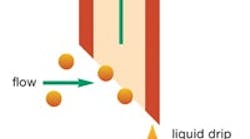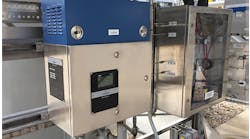PROBE IN CONDENSING GAS STREAM
Figure 3. Droplets collide with exposed portion of inner wall, coalescing into larger droplets that fall from the tip of the probe.
You instead may have to experiment with a square-cut probe, which will maintain a more even internal pressure and minimize bubbling. It may help to locate the nozzle for the probe in the bottom of the line. This way, the probe reaches up into the flow and encourages any bubbles to rise into the process stream and away from the probe. Make the probe wide enough to realize an internal liquid velocity of about 0.1 m/s so the bubbles can escape.A better solution — if feasible — is to find a location with more pressure to prevent bubbling at the probe. If no process pump is available, try moving the sampling tap to a lower elevation in the same line. Liquid pressure increases at lower levels and the higher pressure may suffice to stop the liquid from boiling.Sampling a vapor at its dew point. For such an application, the angle-cut probe is very effective with its entry port pointing downstream. The lower pressure in the probe precludes the possibility of condensation within the probe and may vaporize any fine liquid drops present in the process.However, this might not suit gas pipeline operators, which sometimes want to sample only the hydrocarbon vapor from a line containing condensed hydrocarbon liquids. Obtaining a meaningful vapor sample from this two-phase process stream is notoriously difficult.Using an angle-cut probe pointing downstream isn’t an option, as the pressure drop inside the probe would vaporize some of the liquid droplets and immediately spoil the sample for analysis. Instead, opt for a square-cut probe, as it minimizes the pressure drop and liquid content in the extracted sample. Subsequent sample conditioning is necessary; it hopefully will remove any remaining liquid while ensuring the sample temperature and pressure don’t change. It’s a difficult operation, typically done manually, because the slightest temperature or pressure change causes the entrained liquid to evaporate or some of the vapor to condense, irretrievably ruining the sample.To remove the liquid phase completely without changing sample temperature and pressure, use a special probe that houses a coalescer element or membrane filter in the body of the probe.In less critical applications, an angle-cut probe with the entry port facing upstream also is an option. Because this orientation slightly increases pressure in the probe, liquids won’t vaporize into the extracted sample gas. However, the pressure rise may induce some minor local condensation. This arrangement may improve aerosol removal and liquid drainage, particularly if the sample extraction velocity is low. Figure 3 illustrates the concept: fast moving droplets impinge onto the exposed inner surface of the probe and coalesce to form larger drops that drip back into the pipeline from the sharp tip of the probe.Sampling at a very low process pressure. The small pressure drop caused by an angle-cut probe facing downstream isn’t welcome when you’re sampling from a process stream that’s already at very low pressure. The probe reduces the pressure available to drive the sample to the analyzer location and on to its disposal point, thereby increasing the time delay for analysis.However, if you’re running a fast loop back to process, you can compensate for the lost pressure at the sample takeoff probe by using the same kind of probe in your return tap. The pressure loss will be the same, so the full differential pressure is available across the fast loop.If your sample is clean, point the sample takeoff probe upstream and the sample return probe downstream. This arrangement enhances the differential pressure between the sampling taps. However, remember it also will increase the number of particles in the fast-loop flow.Sampling an upward process flow. It’s often a good practice to locate a sampling probe in a vertical process line flowing upward. If you install an angle-cut probe with its entry port pointing up, you may need to worry about large particles and debris falling against the process flow. If they do, the probe tip will scoop them up and become blocked. To avoid that risk, a straight-cut probe may be a better choice. Or, perhaps less conveniently, you can use an angle-cut probe in a 45° nozzle and align the end parallel to the flow.Sampling a gas containing very fine solids. In most process applications, an angle-cut probe with its entry port facing downstream is very effective because any particles present are too heavy to follow the fluid flow as it turns into the entry port. However, this advantage may be lost when sampling from a gas stream containing particles that are fine enough to stay with the gas as it swirls around the probe. Eddy currents on the downstream side of the probe will carry those particles into the angled portion of the probe. For these types of samples, a square-cut probe is a better choice, as the fine particles will have less of a chance of entering the probe.Sampling for laboratory analysis. Taps for laboratory samples often use angle-cut probes with their entry ports facing upstream. This is the opposite orientation to most probes for continuous process analysis and reflects the laboratory preference for the sample to include any solid particles and liquid droplets carried in the process stream. Laboratory sampling frequently must adhere rigorously to strict industry-standard procedures. Note, however, that a difference in probe orientation may explain a difference in analytical measurements.
MAKE THE RIGHT CHOICEProper probe location and orientation are best determined by process stream conditions and application needs. Angle-cut probes will be your design of choice in most cases. However, you must pay attention to the direction the angle cut faces to account for natural pressure fluctuations on the downstream side of the probe, as well as particles within the process stream. Occasionally, use of an angle-cut probe is ill advised. Instead, you’ll want to opt for a square-cut probe. Ultimately, the right probe design and orientation will help you extract a representative and timely sample to ensure accurate analytical measurements.
CHECK OUT THE ENTIRE SERIES
This is the final article in a three-part series. The first article focused on nozzles — “Properly Position Sampling Nozzles.” The second discussed when to use a probe — “Should You Use a Probe for Sampling?” All three articles are adapted from “Industrial Sampling Systems: Reliable Design and Maintenance for Process Analyzers,” a process sampling textbook authored by Tony Waters and published in 2013 by Swagelok Company. For more information, visit www.industrial-sampling-systems.com
DEAN SLEJKO is product manager, analytical products, for Swagelok Company, Solon, Ohio. E-mail him at [email protected].




